Computer of memory

Memory is the basic component of a computer. It is the internal storage area of the computer. The central processing unit (CPU) needs input device information and instructions to process, which are stored in the memory. The data and instructions stored in the memory are processed and output is obtained. Therefore, memory is an essential part of a computer.
Data Representation
The memory is contained in many cells, these are called locations. Every location has a different level which is called address. The cell is used to store data and instructions. All the data and instructions are present in the computer in the form of binary codes which are represented by 0 and 1. 1 indicates the on state of the circuit and 0 indicates the presence of the circuit. Storing data in a location is called writing and retrieving data from the location is called reading. A certain number of bits can be stored in each location which is called word length and word length 81632 can be of 64 bits. Bit is the smallest unit of binary digital. Bike is a unit of data which is a group of eight bits in EBCDiC (internal binary code decimal interchange code) and seven bits in ASCII (American standard code for information interchange).
Type of memory
There are two types of memory
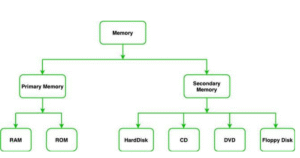
1, primary memory
Primary memory is also of two types, volatile and non volatile. RAM is the main memory in volatile memory and ROM is the main memory in non volatile memory.
2, secondary memory
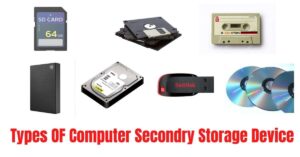
The main secondary memory is hard disk, CD, DVD, pen drive etc.
Different memory
Memory is often referred to as semiconductor storage such as RAM and sometimes other fast and temporary forms. The term memory refers to data storage on a chip, but storage similarities also refer to the storage devices used such as optical disks and hard disks, etc. Memory and storage differ from each other in factors such as price, reliability, speed, etc.
1, Primary memory
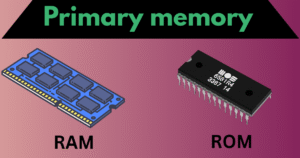
Primary memory, often called main memory, resides inside the computer and its data and instructions are quickly and directly accessed by the CPU.
a, ROM (read only memory)
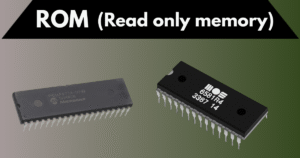
It is a memory in which the stored data or instructions can only be read and cannot be destroyed or changed. It is a permanent memory which is used to keep data in a permanent form in the computer.
ROM is a silicon chip located on the motherboard, the instructions of which are stored in it at the time of its manufacture. When the computer is switched on, the instructions stored in ROM are automatically executed. Even after switching off the computer, the instructions stored in ROM are not destroyed. This permanent program present in ROM is known as BIOS (basic input output system).
b, PROM (programmable read only memory)
This is also a permanent memory. Once the user burns the program instructions, it cannot be changed. Then it behaves like a normal memory.
c, E-PROM (Erasable programmable read only)
It is a permanent memory like PROM but the burning process can be repeated with the help of ultraviolet rays. This is called ultraviolet E-PROM.
d, E-E PROM (Electrically
Erasableprogrammable read only memory)
This is also a permanent memory like E-PROM but the burning process can be done again with the help of electric power plus.
e, Cache memory
It is the part between the CPU and the main memory which is used to store frequently used data and instructions. This eliminates the speed barrier between the main memory and the processor because the speed of reading data from the memory is much slower than the processing speed of the CPU.
f, RAM (Random Access Memory)
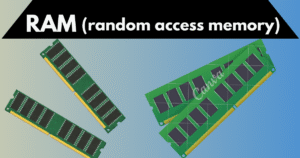
This is the most commonly used memory in computers. It is a permanent memory, which means that if the power supply goes off, the data stored in it is also lost. As is clear from the name, Random Access Memory means that data can be read from anywhere. It is not necessary to read it sequentially. It helps in reading and writing data quickly. RAM is a space where data is loaded and worked upon. RAM is available in capacities like 64 MB, 128 MB, 256 MB, 1 GB etc. RAM is mainly of two types.
1.Dynamic RAM
dynamic RAM data needs to be refreshed frequently.
2.static RAM
Static RAM data does not need to be replaced frequently.
2 secondary memory
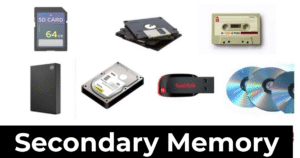
It is also called auxiliary and backing storage memory because the main memory is temporary and has limited capacity, so secondary memory is used as a large amount of permanent data memory. Mostly it is used for data backup. The data which is not currently required by the CPU is stored in the secondary memory and when it is needed, it is copied to the main memory and used. Magnetic tapes and magnetic disks used nowadays are its main examples.
a, Hard dicks
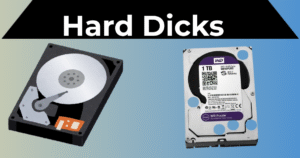
Hard disk is the main device for storing data under CPU. It provides higher storage capacity, reliability and faster speed as compared to disks. Because this text is sealed inside a box with read and write head, it is protected from environment and scratches. Read and write head can directly read and write on any sector of any track of the disk, due to which reading or writing of data happens at a faster speed. In computer, it is often named as C drive. All the programs or data is installed in this hard disk in the computer. We use it according to our requirement. Hard dicks are available in capacities of 10, 20, 40, 500GB etc. Disk is divided into tracks and sectors which is called formatting.
b, CD ROM
CD-ROM is also called optical disc. Data is permanently imprinted on optical disc. With the help of laser, minute pits are made on the surface of CD. Data imprinted on CD cannot be erased. Low intensity laser beam is used to read recorded data. These have track spiral due to which data cannot be read at a faster speed than hard disc. Generally, the storage capacity of CD-ROM is 640MB. A CD drive is required to get data from CD and a CD writer is required to put data on CD. This is also called WORM (Write Once Read Many) disc, that is a CD on which it can be written only once but can be read repeatedly. No change can be made in the imprinted data.
c, CD-R/W(CD Read/write)
CD-R/W is also an optical disc but the data stored on it can be erased or changed. The laser is used to change the reflection of tiny pits on the surface of the CD to store data, and the laser is used again to make changes to the written CD. A CD-R/W drive is required to use this type of CD.
d, Magnetic tape
Magnetic Tape – This is the most successful backing storage medium. In fact, the cassettes we use for storing and recording songs work on the same principle.
Magnetic tape is 2400 to 3600 feet long and is made of polyester. It is wrapped in a reel. In comparison to punch cards and paper tape, huge data can be stored in it. Data can be written, erased or changed in the tape any number of times. And for this, a magnetic tape drive is required. All magnetic tape drives have two reels. One reel of tape which is used for reading or writing is called file reel and the other is called takeup reel.
e, Floppy disk
It mainly comes in three sizes 8 inch, 5.25 inch and 3.5 inch. To protect from dust or scratches, the disc is covered in a plastic cover. The hole made on the top of the cover is used to read or write data. In most disc drives, the read write head is in physical contact with the surface of the disc. Which gets removed after reading and writing, as a result of which there is no damage to the tape. In this, data is written on a circular track. It is an external memory.
Floppy disc is mostly used as a direct access medium.
f, DVD (digital Versatile disc or digital video disc)

DVD is similar to CD-ROM. It can store a minimum of 4.7 GB of data (a full-length movie). DVD is a medium for digitally storing movies and other multimedia presentations. It can be single-sided or double-sided and can store data in one or two layers on each side. A double-sided double-layer DVD can store up to 17 GB of video, audio or other information.
g, pen drive
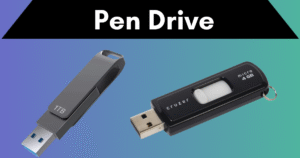
It is shaped like a small key ring and is easily used to transfer and store files between USB (Universal Serial Bus) compatible systems. It is available in different capacities. It is used by plugging it into the USB port of a PC. It is also called a flash drive. This is an example of E-E PROM memory.
i, Flash memory
It is also called flash RAM. It can be erased and reprogrammed. It is used in cellular phones, digital cameras, digital set top boxes, etc.”

8h7di8